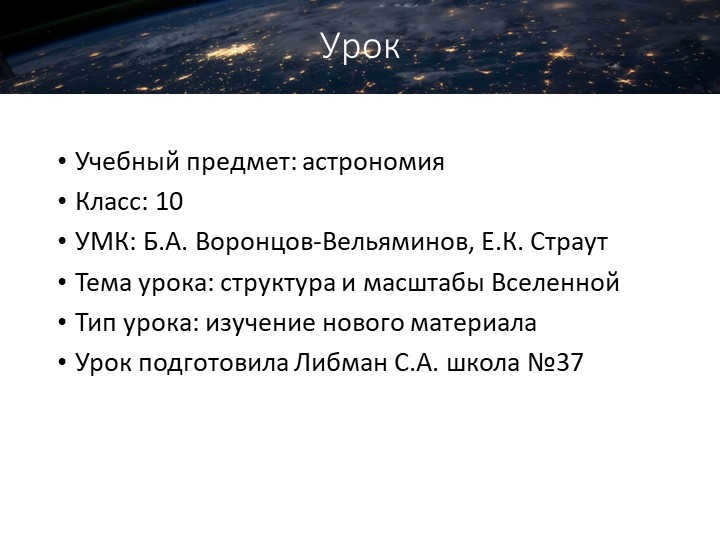
Currently, there are additional cumulative discounts (ranging from 2% to 25%) available for a total of 58,744 educational establishments. To determine the specific discount applicable to all staff members of your educational institution, please log in to your personal Infoworks account.


Course for professional retraining
Planning and implementation of investment projects using various forms of financing.
We can apply your educational institution’s discount to this offer (the amount of discount depends on the number of your colleagues who have completed Infowork courses).
Currently, there are additional cumulative discounts (ranging from 2% to 25%) available for 58,744 educational institutions. To find out the specific discount available for all employees of your educational institution, please log in to your personal Infoworks account.


Enroll in our professional retraining course
Learn how to manage a general educational organization
We have a special offer for your educational institution. We can provide an additional discount based on the number of your colleagues who have already taken Infoworks courses.
Currently, 58,744 educational institutions are benefiting from this offer, with discounts ranging from 2% to 25%. To find out the specific discount available for all employees of your institution, please log in to your personal Infoworks account.


Examining classical Russian literature in a contemporary framework during instructional sessions, taking into account the implementation of the Federal State Educational Standard for General Secondary Education
Outline of the presentation through separate slides:

Lesson 1 Slide
Topic: Astronomy
Grade: 10
Teachers: B.A. Vorontsov-Veliaminov, E.K. Strout
Subject: Structure and Scale of the Universe
Lesson Type: Introduction to New Material
The materials for this lesson were prepared by S.A. Libman, from School No. 37.


2nd slide Lesson
Theme: Structure and Scale of the Universe
Lesson Objective: To develop students’ understanding of the structure of the Universe, the mega-, macro- and micro-worlds, their characteristics and scales.
Lesson Goals:
To develop students’ understanding of the terms “megaworld”, “macro-world”, “micro-world”, to introduce the unit of measurement light-year, to explain the reasons for the existence of the boundaries of knowledge of the world, to analyze the structure of the Galaxy, and types of nebulae

On the third slide, we will discuss the progress of the lesson. The lesson will start with the organizational moment, where we will set the context and objectives. Then, we will justify the relevance of the problem we are addressing. We will also do a quick recap of the material covered so far to ensure understanding. To make the lesson more engaging, we will include a crossword activity. Additionally, we will watch a video clip related to the topic to enhance our learning. We will then move on to explore new information about the mysteries of the universe. Finally, we will summarize the lesson and assign homework for further practice.


Slide 5: Relevance of the Topic
The present-day circumstances of human existence necessitate a comprehension of space exploration and the application of advancements in cosmonautics.
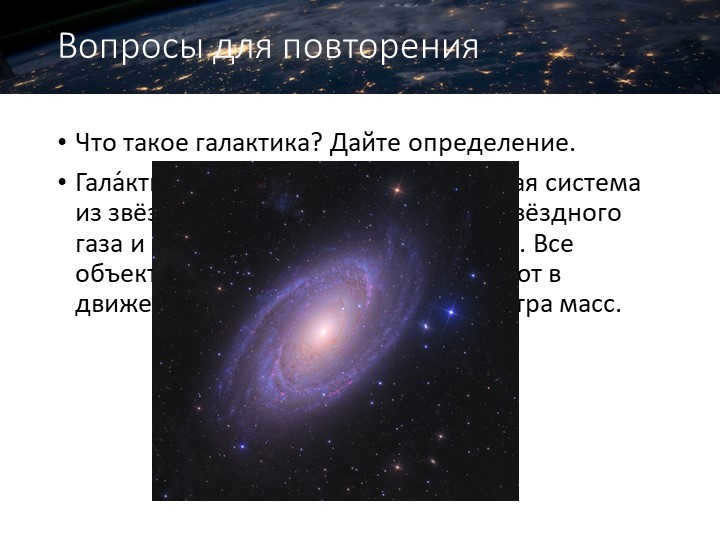
6 slide Questions for repetition
What is the structure of a galaxy? Provide a definition.
A galaxy is a collection of stars, star clusters, interstellar gas and dust, dark matter, and planets that are held together by gravity. All the objects within a galaxy move in relation to a shared center of mass.
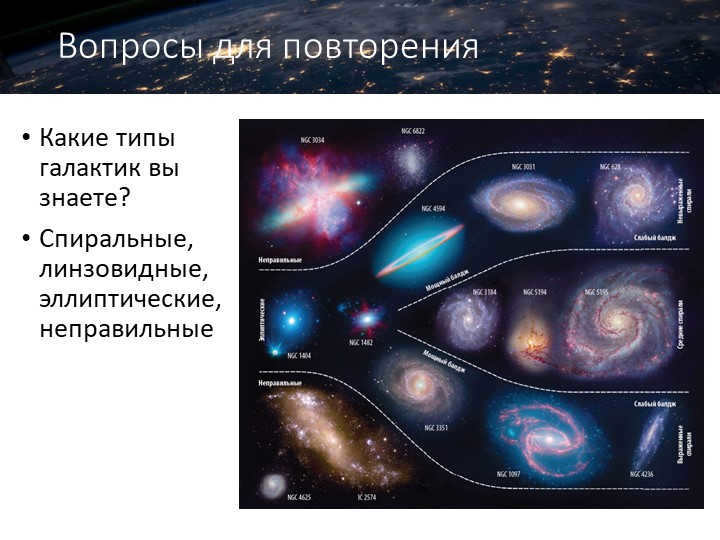
Slide 7 Repetition Questions
What are the different types of galaxies that you are familiar with?
Spiral, lenticular, elliptical, irregular.
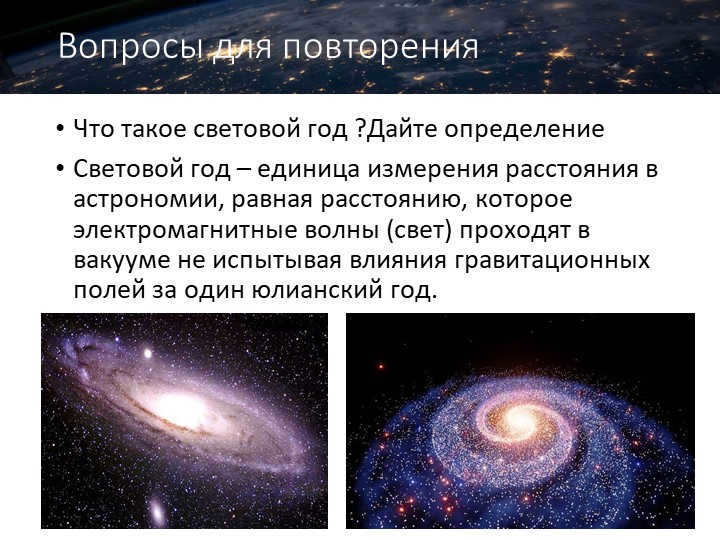
Here are 8 questions to review:
What does the term “light year” mean? Can you provide a definition?
A light year is a unit of measurement used in astronomy to represent the distance that light travels in a vacuum over the course of one Julian year, without being affected by gravitational fields.
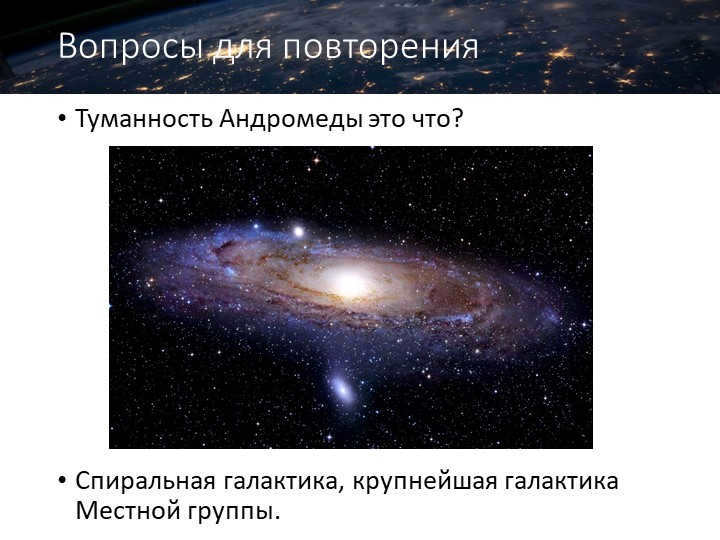
Here are 9 questions to review:
What is the Andromeda Nebula?
The Andromeda Nebula is a spiral galaxy, and it is also the largest galaxy in the Local Group.
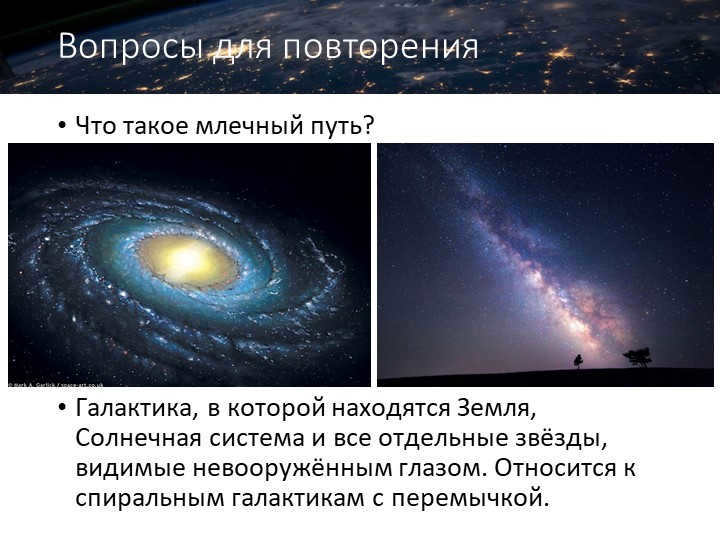
10 slide Questions for Review
What is the Milky Way?
The Milky Way refers to the galaxy where our Earth, solar system, and all the stars that we can see without a telescope are located. It is classified as a spiral galaxy with a central bulge.
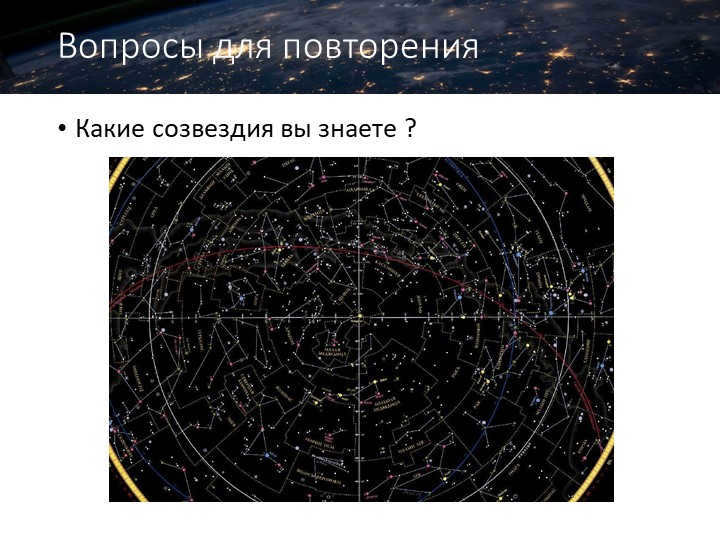
12 slide Horizontal
3. matter is composed of it
5. It measures the air pressure
6. Component of a molecule
7. Scientist from Kholmogorsk
9. Maintains volume but not shape
14. Alteration in shape, size, and volume of the object
15. Reaction that produces heat and light
16. Space beyond the Earth that includes planets, stars, etc.
Vertically
1. The state of the lower atmosphere
2. Constituent of a body
4. A person who studies celestial bodies
6. It is an element of air
8. Reacts with oxygen
10. Mutual penetration of substances
11. Property of a body to change shape under the influence of
12. Line dividing the Earth’s hemispheres
13. Force that holds particles together
16. Mixture of gases suitable for breathing

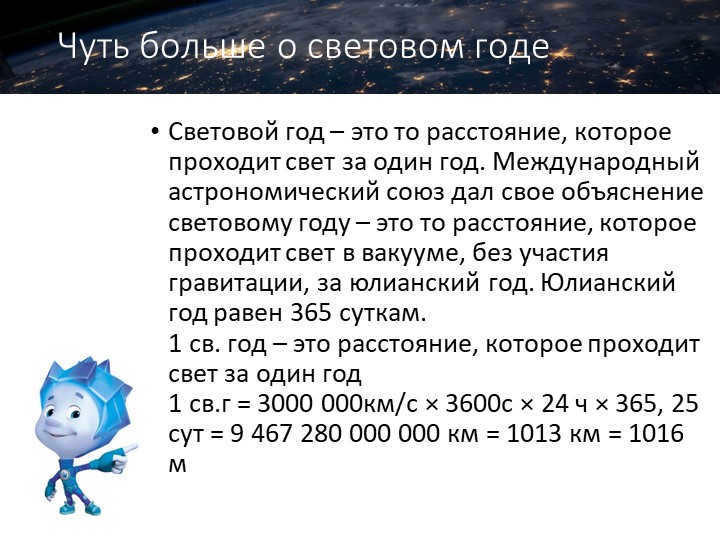
Slide 15 Here are some more details about the light year.
A light year is a unit of measurement that represents the distance light travels in the span of one year. The International Astronomical Union has provided a definition for the light year – it is the distance that light can travel through a vacuum, free from the effects of gravity, over the course of a Julian year. A Julian year consists of 365 days.
1 light year is equivalent to the distance that light can travel in one year
1 light year = 300,000 km/s × 3600 s × 24 h × 365.25 days = 9,467,280,000,000 km = 1.013 × 10^13 km = 1.016 × 10^16 m
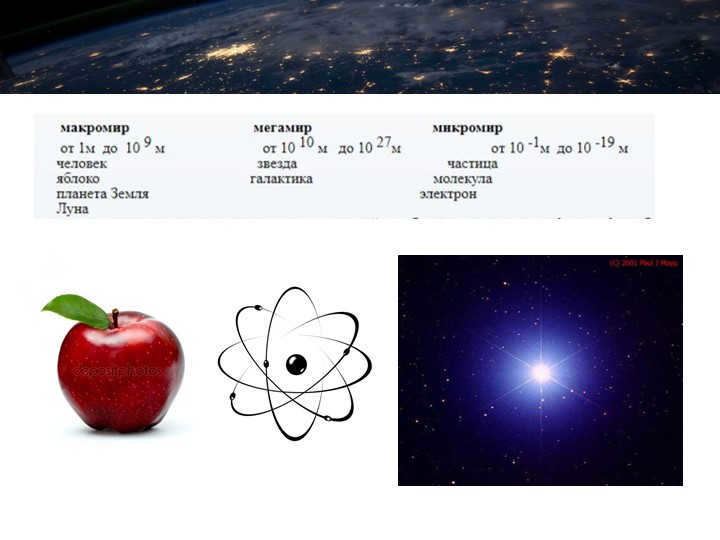
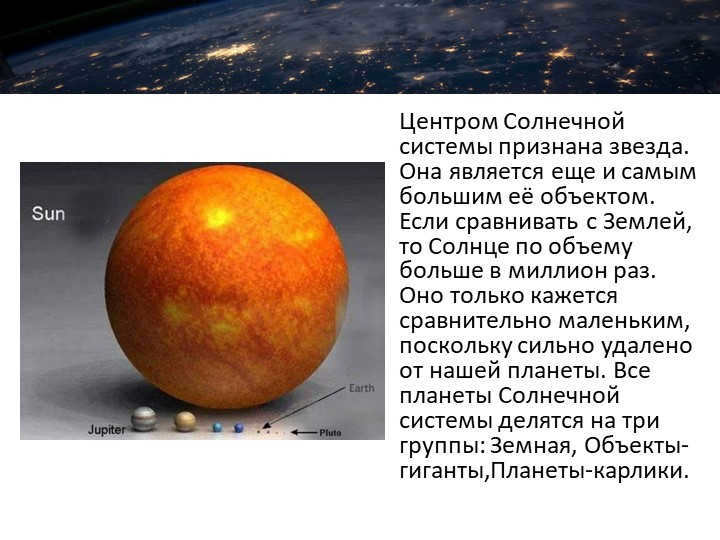
Slide 18: The star at the heart of our solar system is identified as the center. It also happens to be the biggest entity within it. In terms of volume, the Sun is a million times larger than the Earth. However, due to its distance from our planet, it appears relatively small. The planets in our solar system can be classified into three categories: Terrestrial, Giant Objects, and Dwarf Planets.
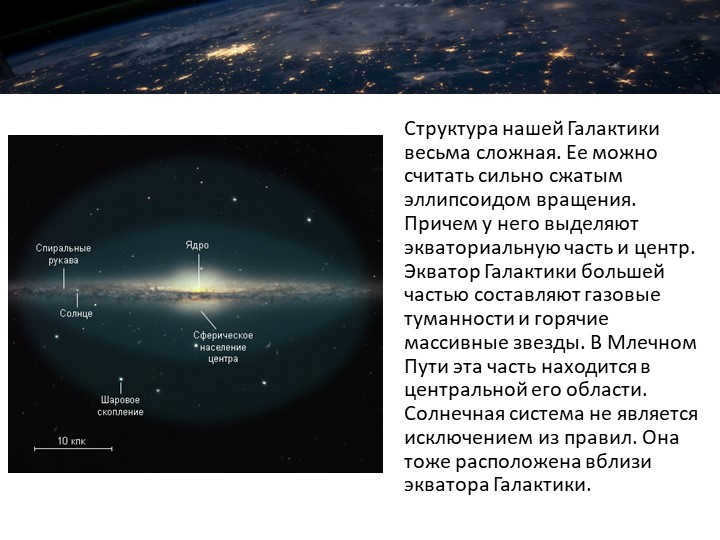
Slide 19: The configuration of our galaxy is incredibly intricate. It can be described as a densely packed rotating ellipsoid, consisting of both an equatorial region and a central core. The equatorial portion of the galaxy is primarily composed of gas nebulae and highly massive stars. Within the Milky Way, this section is situated in the central area. The solar system is not an anomaly in this regard, as it also resides close to the galactic equator.
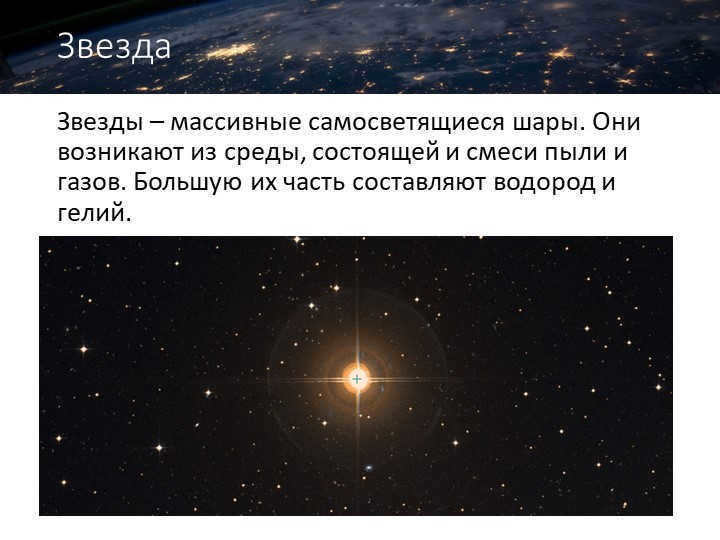

There are 20 slides about stars.
Stars are huge, luminous celestial bodies. They originate from a substance composed of a combination of particles and gases. The majority of them are composed of hydrogen and helium.
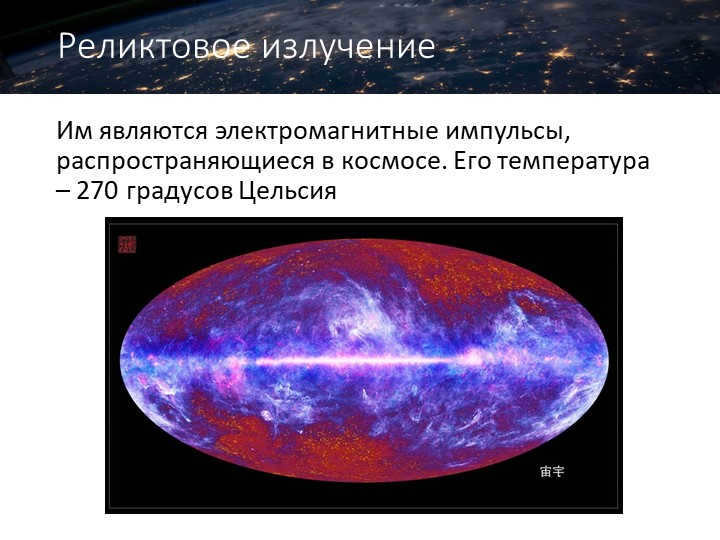
Relict radiation is a phenomenon characterized by the propagation of electromagnetic pulses in space. These pulses have a temperature of 270 degrees Celsius.

Slide 22 is all about dark matter.
Dark matter refers to the mass that is not visible. It includes objects in the universe that cannot be directly observed. In simpler terms, dark matter does not emit electromagnetic waves, but it does have gravitational effects on other celestial bodies.
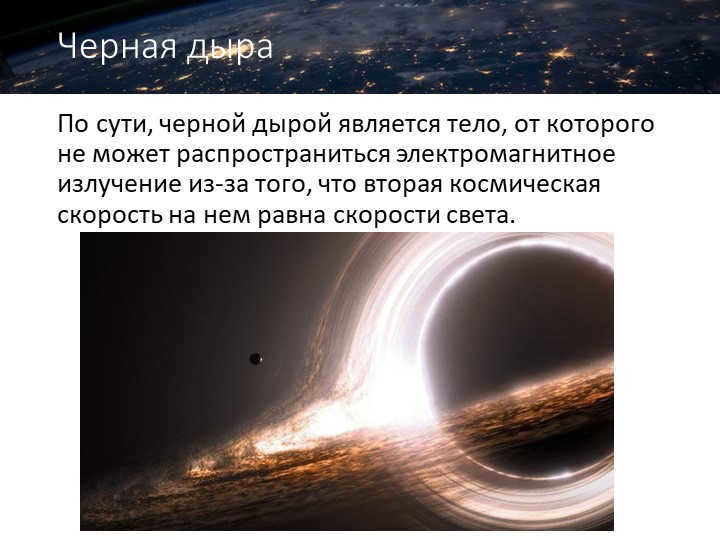
Slide 23: The concept of a black hole
A black hole can be defined as an object that hinders the propagation of electromagnetic radiation, as its escape velocity is equal to the speed of light.
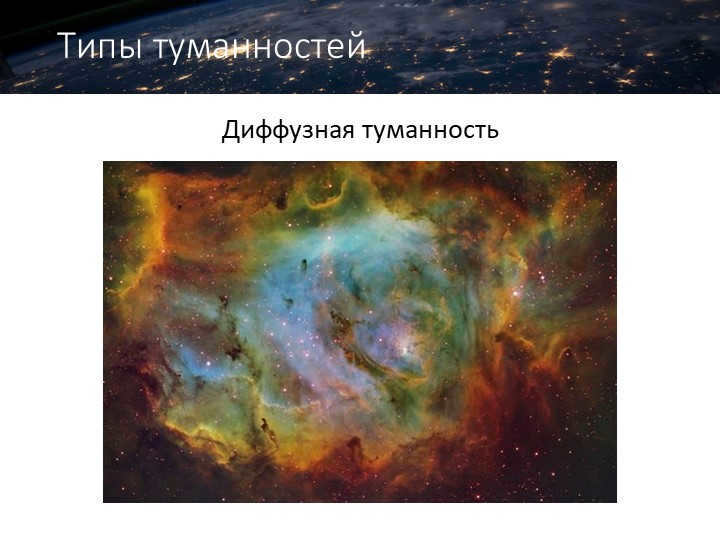
There are 25 different types of nebulae, and one of them is the reflection nebula.
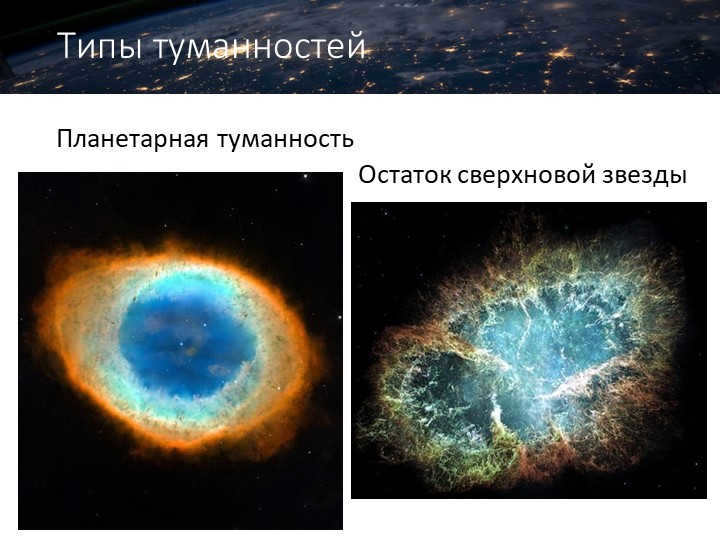
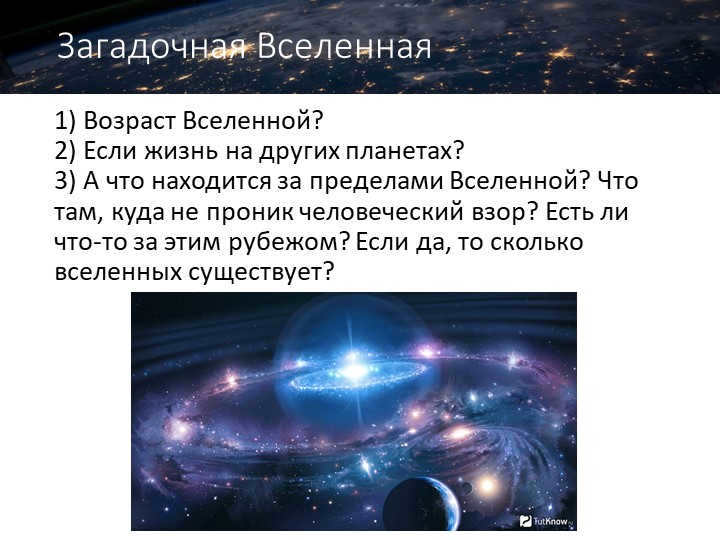
Slide 27: Unveiling the Enigma of the Universe
1) How old is our vast cosmos?
2) Could extraterrestrial life exist in distant galaxies?
3) What lies beyond the cosmic sphere? What mysteries lie undiscovered by human vision? Does a vast unknown realm exist beyond this celestial boundary? And, if so, how many parallel universes coexist?


Worksheets and resources for instructors and educators
More than 10,000 educational materials for both classroom and remote learning.

At present, there are extra cumulative discounts (ranging from 2% to 25%) that can be availed by 58,744 educational establishments. To determine the applicable discount for all staff members of your educational institution, please sign in to your personal Infoworks account.


Professional retraining course
Planning and implementation of investment projects with various financing methods
We have the ability to apply your educational institution’s discount to this offer (the amount depends on the number of your colleagues who have completed Infoworks courses).
Currently, there are additional cumulative discounts (ranging from 2% to 25%) available to 58,744 educational institutions. To determine the discount available to all staff members of your educational institution, please log in to your personal Infoworks account.


Professional Development Program
Effective School Management
We can apply a discount for your educational institution in addition to the existing discount (the amount will depend on the number of your colleagues who have completed Infowork courses).
Currently, there are additional cumulative discounts available (ranging from 2% to 25%) for 58,744 educational institutions. To find out the discount available for all employees of your educational institution, please log in to your personal Infoworks account.


Exploring classical Russian literature in a contemporary setting during lessons, taking into account the implementation of the FSES SOOO
Description of the presentation through individual slides:

Slide 2: The Universe
The Universe is the vast expanse of space that encompasses everything in existence. It is a cosmic playground filled with an infinite array of matter and energy, ranging from the tiniest building blocks of nature to colossal celestial bodies like galaxies and everything in between.
Within the Universe, we find a multitude of fascinating entities, including planets, stars, asteroids, and even entire galaxies. Our very own solar system is just a tiny speck within the grand tapestry of the Universe, which stretches far beyond our wildest imaginations.
One of the most awe-inspiring components of the Universe is our very own galaxy, the Milky Way. It is a vast collection of stars, gas, dust, and other celestial objects, swirling together in a mesmerizing cosmic dance. And yet, the Milky Way is just one among countless other galaxies that exist in the Universe.
The Universe is a never-ending source of wonder and discovery. It holds the answers to some of the most profound questions we ask about our existence and the nature of reality. Exploring the Universe is an ongoing journey of exploration and learning, as we strive to unravel its mysteries and unlock the secrets it holds.

3 slide 1 astronomical unit is approximately equal to 149, 6 million kilometers or about 150 million kilometers.
1 pc (parsec) is equivalent to 206265 astronomical units or approximately 3.26 solar years.
1 light-year (sv. year) is defined as the distance that a ray of light, traveling at a speed of nearly 300,000 km/s, covers in the span of 1 year. It is equivalent to a staggering 9.46 million million million kilometers!
The Universe, as we know it, encompasses the largest conceivable region of space, comprising of all celestial bodies and their respective systems that are available for scientific exploration.
It is plausible that the actual reality may be structured in such a manner that there exist other universes with distinct laws of nature and potentially different values for physical constants.
The Universe, in its entirety, forms a remarkable and all-encompassing system that encompasses the entirety of the material world, extending limitlessly in space and exhibiting an infinite variety of forms.
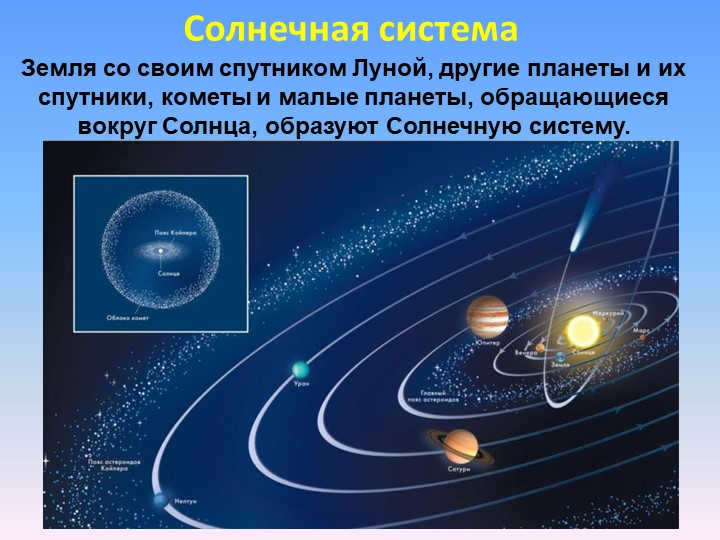
The Solar System consists of the Earth along with its satellite, the Moon, as well as other planets and their satellites, comets, and small planets. These celestial bodies orbit the Sun, creating the structure of the Solar System.
The Solar System
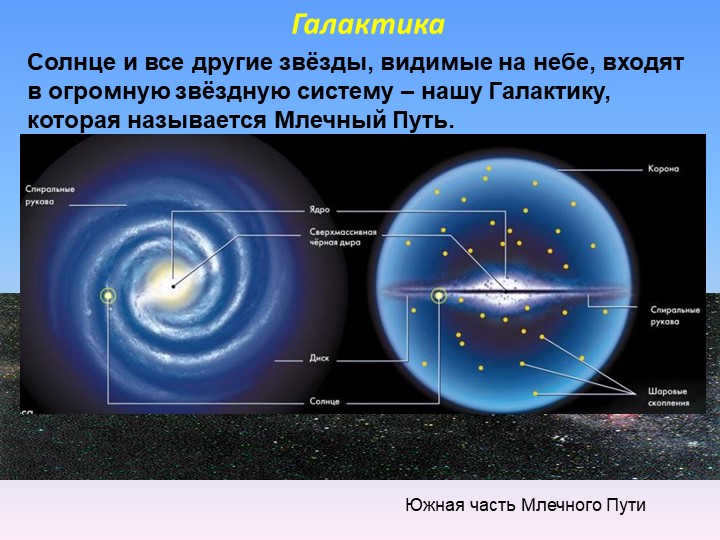

Slide 5: Exploring the southern region of the Milky Way
Galactic exploration
Our solar system, along with the countless stars that adorn the night sky, is situated within the vast expanse of our galaxy known as the Milky Way.
Contained within the Milky Way are several hundred billion stars, each with its own unique story to tell.
To put the immense scale of our galaxy into perspective, it takes light over four years to travel from the nearest star to our solar system, and yet it would only take light approximately 100,000 years to traverse the entire length of the Milky Way.
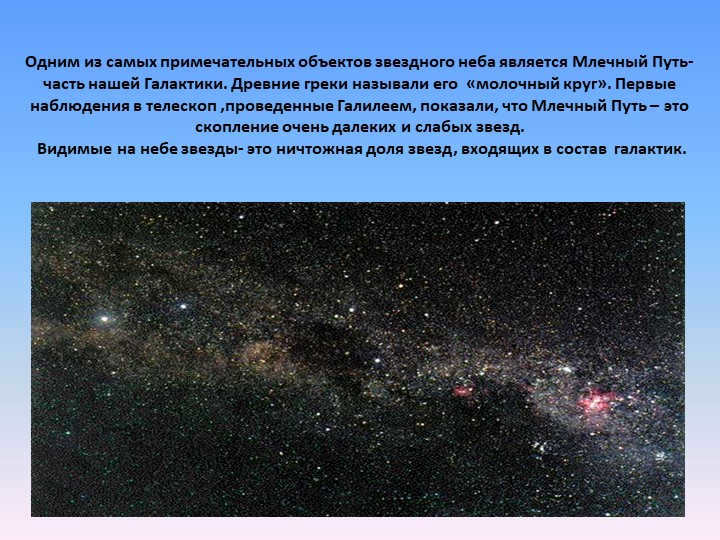

Slide 6
One of the most extraordinary sights in the celestial sphere is the Milky Way, also known as our Galaxy. The ancient Greeks referred to it as the “milky circle”. The initial observations through a telescope conducted by Galileo revealed that the Milky Way consists of a multitude of distant and faint stars.
It is worth noting that the stars visible to the naked eye represent only a small percentage of the total number of stars present within galaxies.
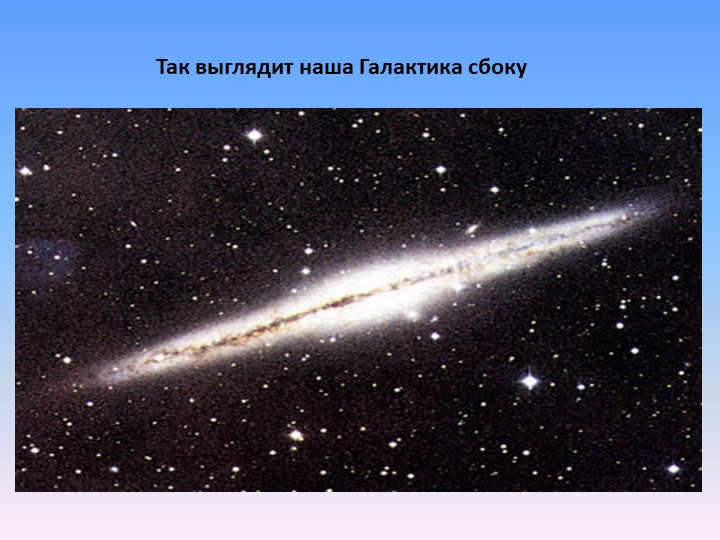
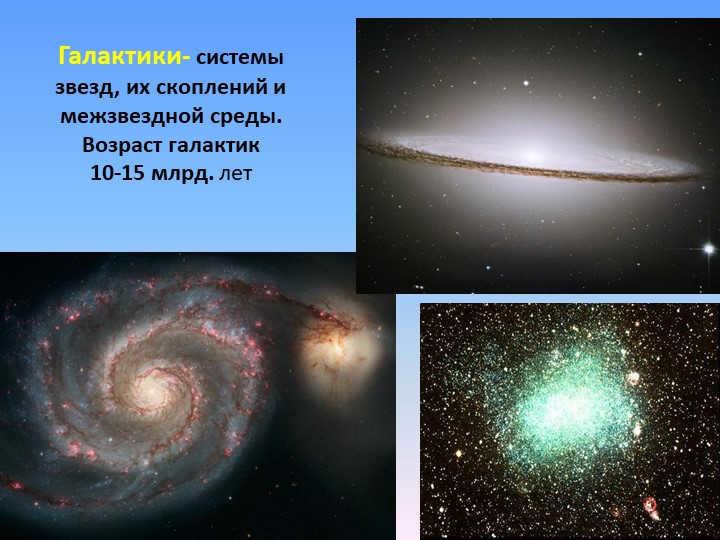
Galaxies are celestial entities composed of stars, their clusters, and the interstellar medium. The age of these galactic systems is estimated to be around 10-15 billion years.
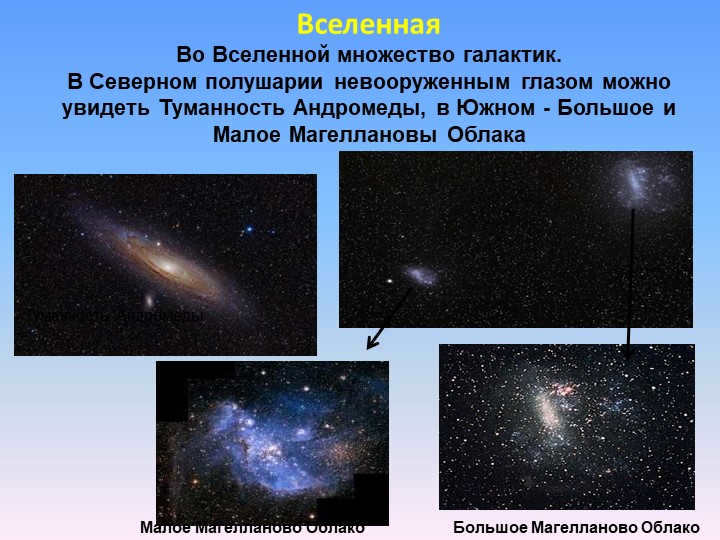
Slide 10: The Universe is home to a multitude of galaxies.
In the Northern Hemisphere, one can easily spot the Andromeda Nebula with the naked eye, while in the Southern Hemisphere, the Large and Small Magellanic Clouds are visible.
The Large Magellanic Cloud
Universe
Andromeda Nebula
Small Magellanic Cloud
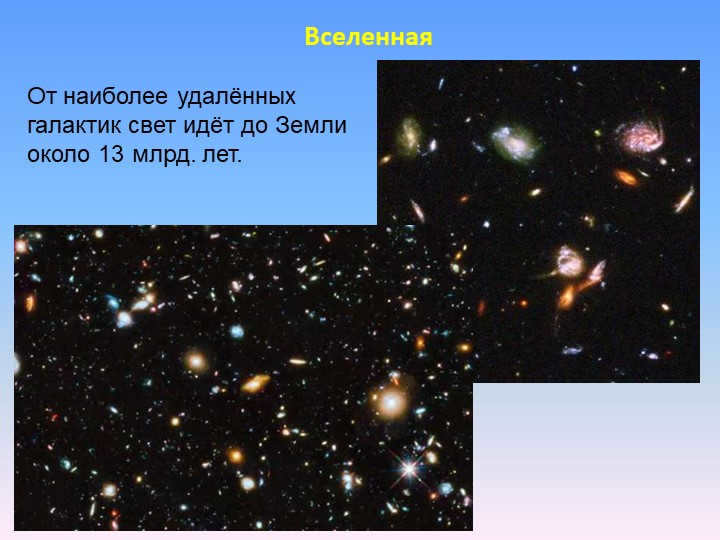

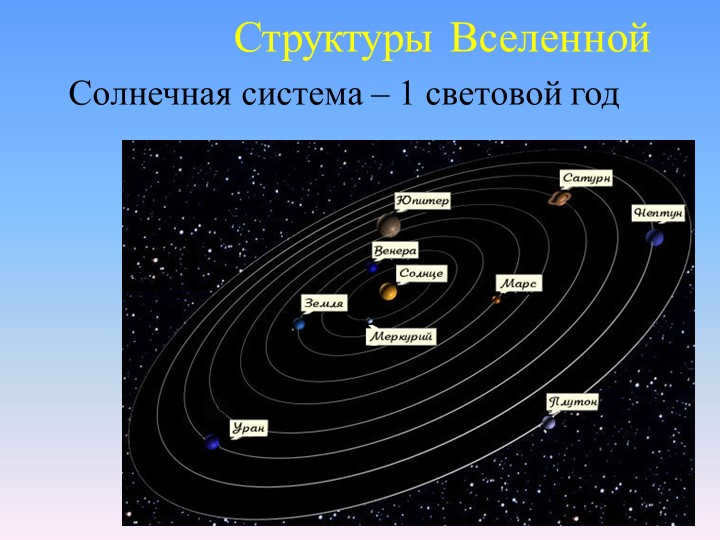
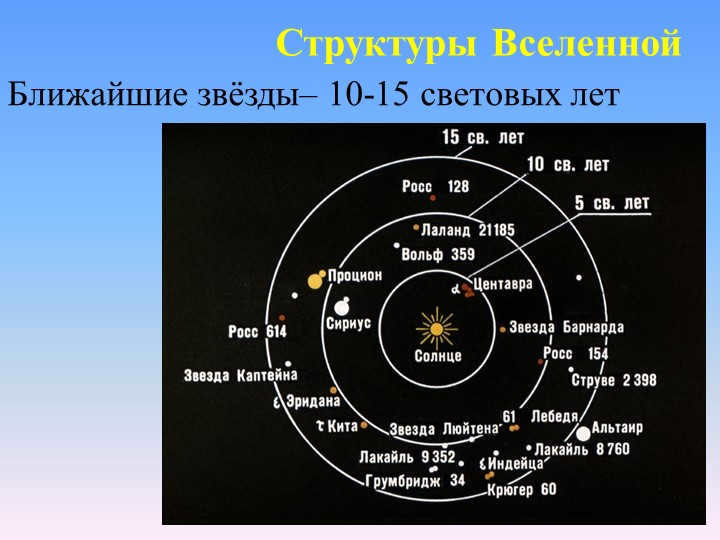
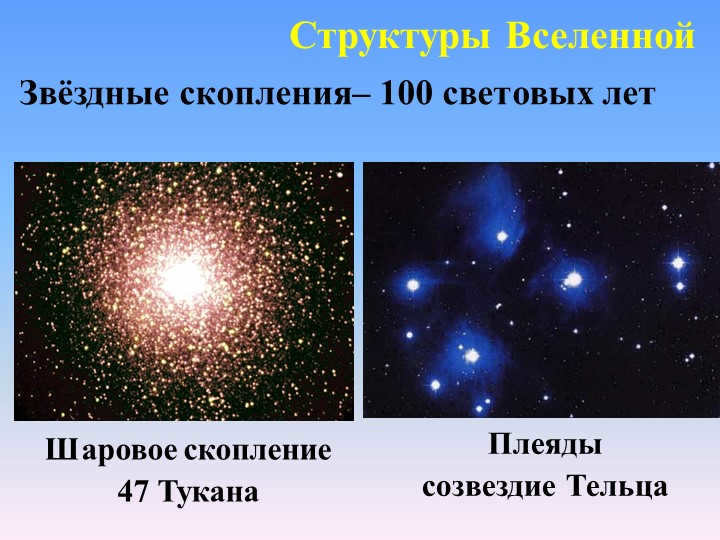
There are 16 slides depicting the Structures of the Universe, specifically the Pleiades constellation in Taurus.
These star clusters are located 100 light years away.
One notable cluster is the Globular cluster known as 47 Tucana.
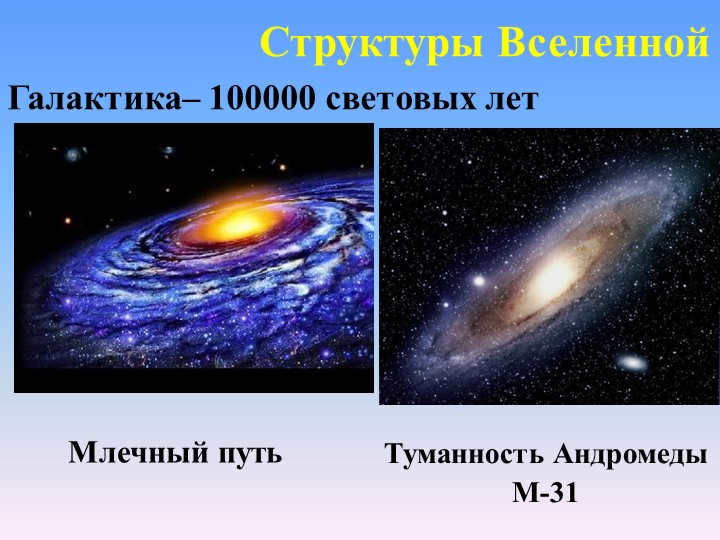
Slide 17 Structures of the Universe
Galaxy – spanning 100,000 light years
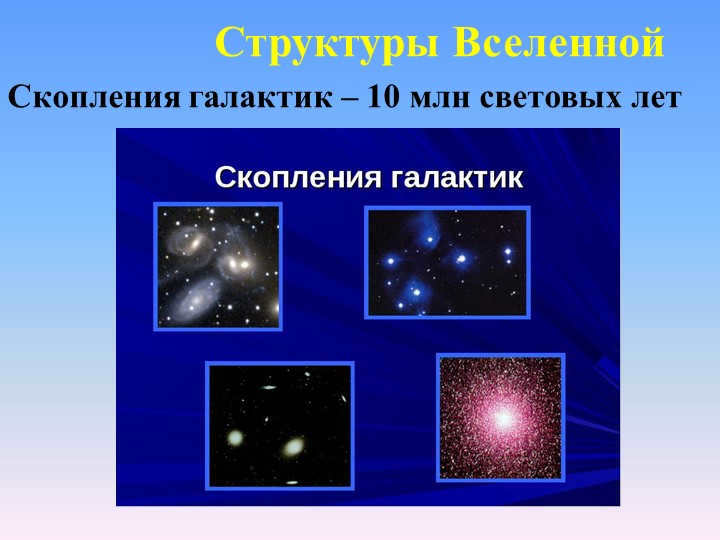
Slide 18 Structures of the Universe
Galaxy clusters – spanning 10 million light years
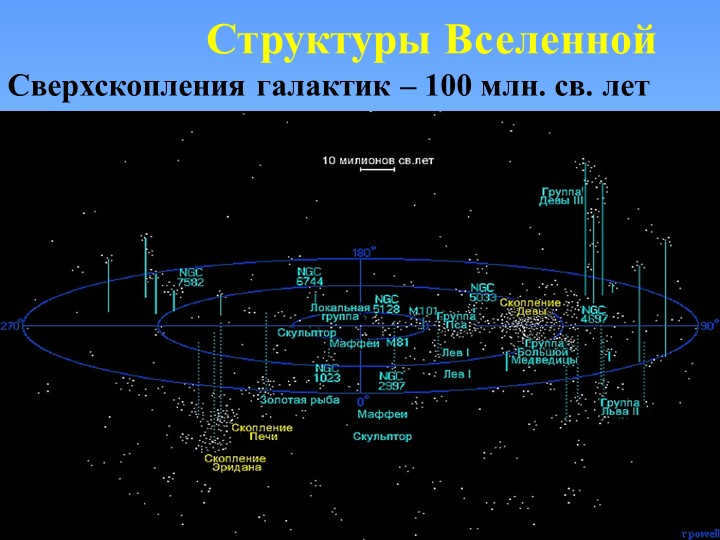
Slide number 19 showcases the various structures found in the Universe, specifically highlighting the super clusters of galaxies that span an impressive distance of 100 million light years.
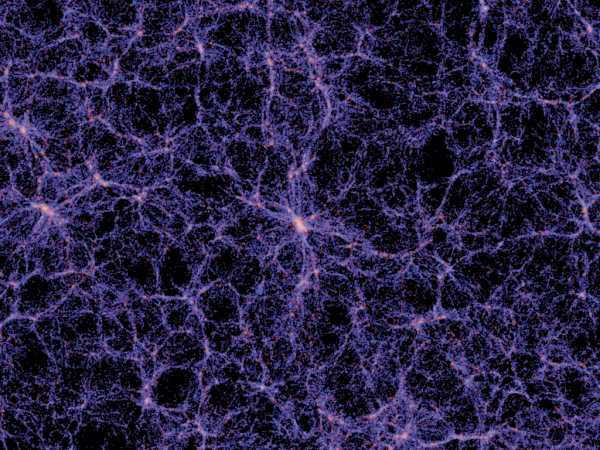
The arrangement of matter in the Universe on a grand scale is known as the large-scale structure of the Universe. This term describes the way in which matter is distributed across the largest observable scales in the Universe.
An illustration of the most basic formation found in the vastness of outer space is the planetary satellite configuration. With the exception of the two innermost planets, Mercury and Venus, each of the other planets in our solar system boasts a satellite, and in the majority of instances, multiple satellites. While Earth is graced with just one, the Moon, Jupiter is encircled by a staggering 67 satellites, albeit some of them being of diminutive size. Nevertheless, alongside their respective satellites, the planets of our solar system orbit around the Sun, giving rise to the phenomenon known as a planetary system.
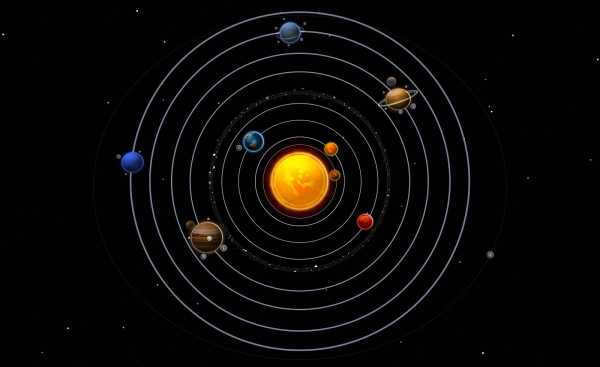
Based on observations, astronomers have discovered that the majority of other stars also exist within planetary systems. Additionally, these stars often form systems and clusters known as stellar systems. According to available data, it is reported that the majority of stars are part of paired stellar systems or systems with multiple stars. In this regard, our Sun is considered atypical as it does not have a companion.
If we zoom out and consider the space surrounding our Sun on a larger scale, it becomes evident that all the star clusters and their planetary systems come together to form a star island known as the Milky Way galaxy.
The Evolution of Understanding the Composition of the Universe
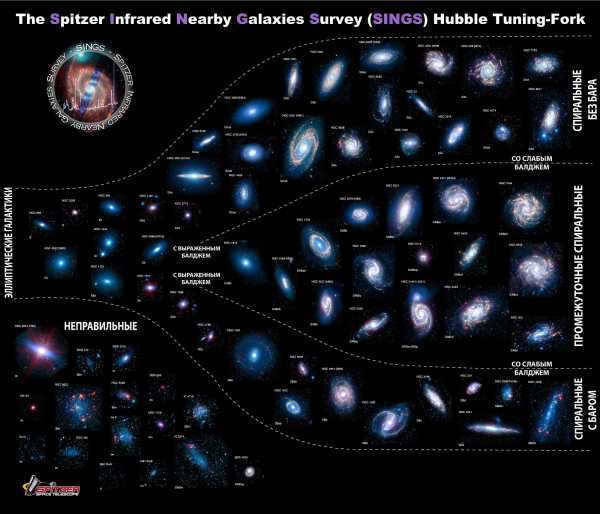
A range of galaxies were uncovered during the SINGS project. Take a look at the complete image.
The concept of the immense structure of the Universe was initially contemplated by the renowned astronomer William Herschel. It was Herschel who made significant discoveries like finding the planet Uranus and its two moons, two moons of Saturn, discovering infrared radiation, and proposing the idea of the solar system’s motion through space. By constructing his own telescope and conducting observations, he made calculations regarding the volume of celestial bodies with varying levels of brightness in specific areas of the sky. This led him to conclude that there exists a vast number of stellar clusters in the outer regions of space.
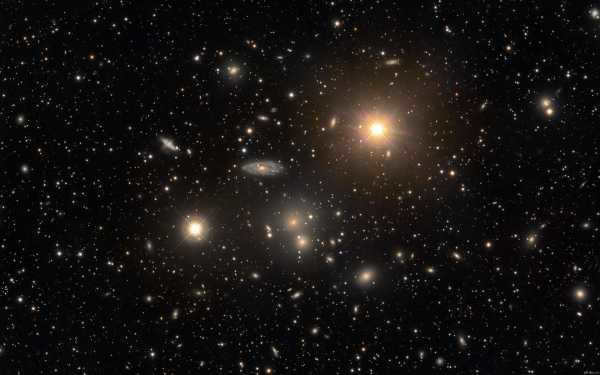
A group of galaxies located in the Hydra constellation.
The structure of the Universe on a large scale
Over time, scientists have come to realize that individual galaxies are quite uncommon in the Universe. The majority of galaxies form clusters on a large scale, which can have different shapes and consist of two galaxies or multiples of two galaxies, up to several thousand. Alongside vast collections of stars, these immense stellar structures also contain clusters of gas that are heated to high temperatures. Despite having a very low density (thousands of times less than that of the solar atmosphere), the mass of this gas can surpass the total mass of all the stars in certain galaxy clusters.
Based on observations and calculations, scientists have concluded that clusters of galaxies have the potential to create additional, larger structures. This discovery has raised two fascinating questions: if a galaxy, which is already a complex structure, is a part of a larger structure, could that larger structure itself be a component of something even more expansive? And, in the end, is there a boundary to this hierarchical structuring, where each system is a part of another?
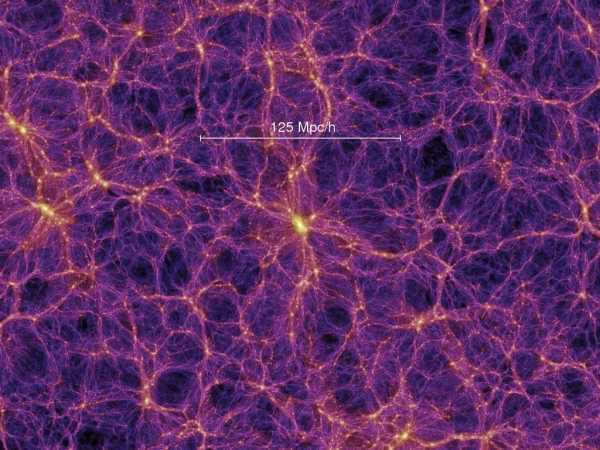
The structure of the universe bears a striking resemblance to the intricate network of neurons found in the human cerebral cortex.
The confirmation of the first question lies in the existence of supercollisions between galaxies, which eventually lead to the formation of galactic filaments, also known as “walls”. These structures are typically 10 million sv. years thick and 160 – 260 million light years long. However, when addressing the second question, it is important to note that super clusters of galaxies are not isolated entities, but rather denser regions within the galactic walls. Therefore, scientists now believe that the fibrous or cellular structure of the Universe is formed by the interweaving of galactic filaments (walls), the largest cosmic structures, with howdah (empty space devoid of star clusters).
The Earth’s Position within the Universe
Deviating slightly from the subject, let’s explore the placement of our planet within this intricate structure:
- Solar System: Planetary
- Interstellar Cloud: Local
- Arm of Orion: Galactic
- Galaxy: Milky Way
- Galaxy Cluster: Local Group
- Galaxy Supergroup: Local Supergroup (Virgo)
- Galaxy Supergroup: Laniakea
- Wall: The Pisces-Keith Superscope Complex
According to recent research, the Universe is comprised of a minimum of 200 billion galaxies. These galactic walls possess a relatively flat nature and form the boundaries of the Universe’s “cells,” while their intersections create superclusters of galaxies. At the center of these cells lie voids.

The Universe’s scale of interactivity
Scientists have determined that the distribution of galaxies in the three-dimensional model of the Universe forms a cellular structure that can be observed in any direction for distances exceeding a billion light years. This discovery implies that, on a scale of several hundred million light years, every part of the Universe contains a similar amount of matter. These findings provide evidence for the homogeneity of the Universe at these scales.
Reasons behind the immense structure of the Universe
Despite the presence of notable structures like galactic walls and filaments, galaxy clusters are still regarded as the most substantial and stable formations. This is due to the fact that the expansion of the Universe, which is widely known, gradually stretches the structure of all objects, and only gravity can counteract this force. Through examining clusters and super clusters, a remarkable phenomenon called “gravitational lensing” has been discovered. This phenomenon demonstrates that rays passing through interstellar space become curved, indicating the presence of an immense, unseen mass within it. This mass could potentially be associated with various undetectable cosmic entities, but on this scale, it is most likely linked to dark matter.
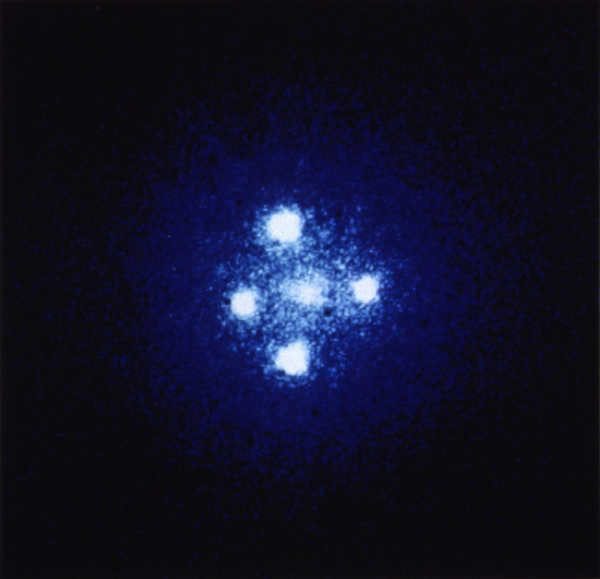
Einstein’s Cross is a quasar that has been gravitationally lensed.
Scientists have long believed that the matter in the Universe should be evenly distributed, based on the almost uniform relic radiation. However, gravity has a unique effect of pulling particles together, creating dense structures that disrupt this uniformity. After the Big Bang, small variations in the distribution of matter began to condense into larger structures over time. These structures, with their increasing mass and gravity, eventually slowed down the expansion of the Universe until it came to a halt. In some regions, the expansion even reversed, leading to the formation of galaxies and galaxy clusters.
A computer analysis confirmed the validity of this model. By considering minuscule fluctuations in the uniformity of the cosmic background radiation, the computer determined that these same small fluctuations in the matter distribution following the Big Bang could have potentially caused the formation of galaxy clusters and the intricate large-scale structure of the Universe through the influence of gravity.
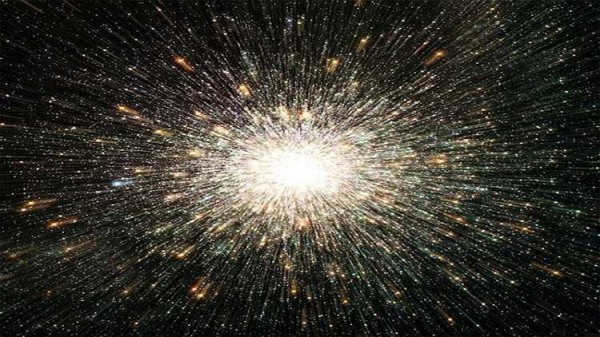
The Universe is an immense stretch of dark matter, countless galaxies, and stellar clusters. It knows no bounds in space or time. The expansive realm of space conceals numerous enigmas that can only be unraveled by understanding the laws of cosmic evolution and comprehending the intricate makeup of the Universe.
Where did the universe originate?
It is difficult to fathom, but the immense expanse of the cosmos was once confined to a single point for 14 billion years. A compact and intensely hot ball of protomatter.
In an instant, this point erupted, causing the minuscule components to disperse. This theory, known as the Big Bang Theory, offers the most rational explanation for the birth of the universe and remains the predominant hypothesis.

All the particles that originated from the explosion dispersed from the center of the event and eventually started to engage with one another. Clusters were formed from the scattered material, which later evolved into stars.
Galaxies were created as a result of the combined effects of centrifugal and gravitational forces.
The expansion of the Universe and the formation of new “compactions” happen continuously. This is why scientists face challenges in defining the boundaries of the universe.
Evolution
Based on the trustworthiness of the Big Bang Theory, scientists postulate that the progression of the cosmos transpired in the following order:
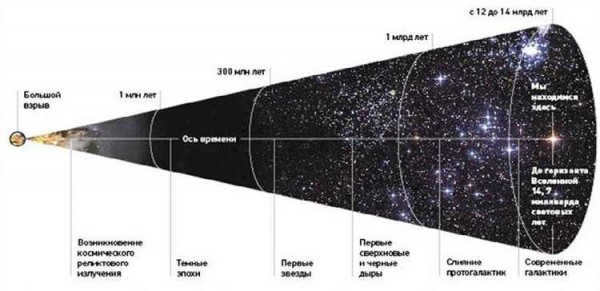
The Era of Singularity
This marks the initial stage of the universe’s development. A minuscule point, comprising of protons and neutrons, undergoes a tremendous “explosion”. This momentous event lasts only for 0.0001 seconds. Subsequently, the synthesis of particles commences, resulting in the formation of hydrogen and helium. This process occurs at incredibly high temperatures, reaching billions of degrees, allowing for rapid progress and the expansion of the cosmos.
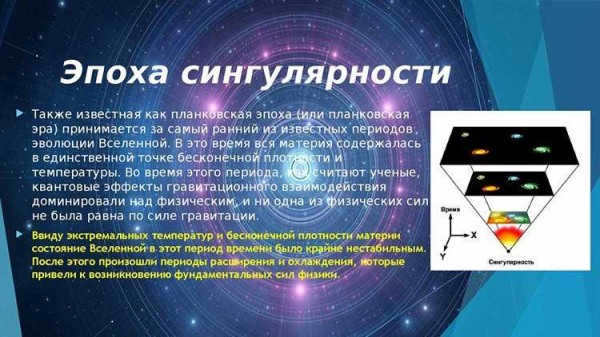
The Era of Inflation
At this particular time, the immense expanse of the cosmos was brimming with energy of an equally intense density, unfathomably high temperature, and immense pressure. As a result, there ensued a rapid process of expansion accompanied by a gradual decrease in temperature. This epoch holds great importance due to the occurrence of particle-antiparticle collisions and annihilation, ultimately leading to the prevalence of matter over antimatter.
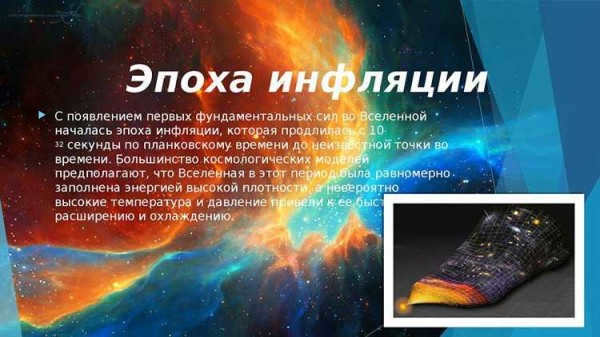
The period of cooling
The reduction in density and temperature in the vastness of the universe led to the minimization of energy in each individual particle. These transformations took place until all elementary particles converted into their current states. Throughout this era, dense matter was uniformly spread throughout the expanse of space.
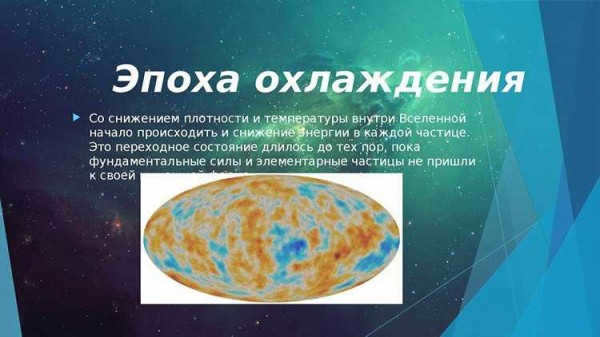
The Age of Hierarchy
Throughout billions of years, the most compact areas gradually united, giving rise to gas clouds, stars, and galaxies. During this period, the fundamental structures of our Universe took shape, which can be witnessed today.
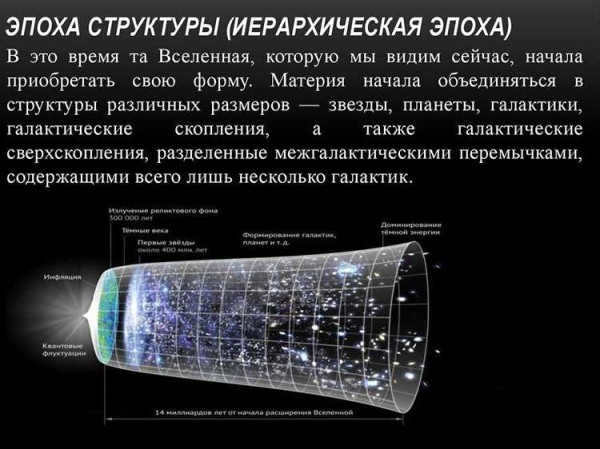
The fundamental components of the universe’s structure
The arrangement of the universe on a large scale plays a crucial role in determining its composition and structure. Within the vast expanse of the universe, one can observe filaments and voids that give rise to superclusters, galaxies, and stars. The initial phase of the universe’s structuring begins with the formation of hydrogen gas, which, under the influence of gravitational forces, condenses into dense, massive clumps. These clumps possess a mass thousands of times greater than that of any individual galaxy. In regions where there is a high concentration of hydrogen gas, megalaxies come into being. Meanwhile, in regions with less gas, smaller star systems similar to our Milky Way form.
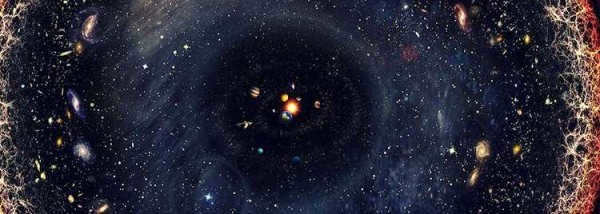
Spin too fast, and protogalaxies transformed into spiral star homes. Meanwhile, regions with slower rotation experienced compression of hydrogen gas, resulting in the creation of irregular, elliptical galaxies.
Simultaneously, superclusters formed, with their outer boundaries in contact. Each of these structures harbored stars, nebulae, and cosmic dust. However, the most significant constituent is dark matter.
“Star residences”: categorization and characteristics
Precise details regarding the classifications and boundaries of galaxies were discovered through studies performed by Edwin Hable. The astrophysicist proposed the subsequent categorization:
- Spiral. These are the most prevalent “star residences”. They manifest in the form of distinct spirals that either cluster around the core or radiate from the galactic “hub”. Our Milky Way belongs to this category. Another well-known representative of spiral galaxies is our “neighbor” – Andromeda. It is hurtling towards us rapidly, which may result in a collision between these two stellar residences.
- Elliptical. They possess a non-uniform configuration. There is a multitude of them dispersed throughout the vast expanse of the universe, yet their appearance lacks distinctiveness due to the absence of interstellar matter and cosmic particles. The “ellipses” solely comprise star clusters.
- Irregular. These objects lack precise boundaries and have an indeterminate form. They consist of interstellar gas clouds and cosmic dust. Such “stellar abodes” may become assimilated by larger entities.
Each of these celestial entities represents a distinctive formation with an enigmatic structure.
The fate of the Universe
The Universe originated from a tiny speck. Its rapid growth and expansion led to the creation of immense cosmic territories. However, will this expansion come to a halt? Is it possible for the Universe to reverse its development and compress back into its original dense point?
In the 1990s, scientists arrived at the conclusion that two potential scenarios for the future of the Universe are plausible.
It is conceivable that the cosmic expanse could undergo a “compression”! Once it reaches its maximum size, it might collapse. The density of dark matter could reach critical levels, triggering a contraction.






